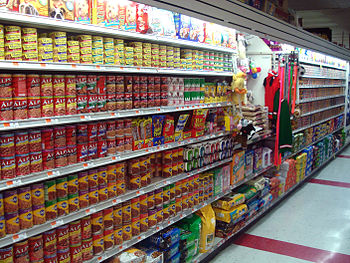Cat and dry food
Different cats will eat different amounts of food during a day. Much will depend on the age and breed of the cat, as well as its metabolism. Some cats are finicky eaters and pick at their meals, and some will keep asking for more. Rather like humans, I guess.
A good rule of thumb for feeding a healthy adult cat weighing around 5.5lb or2.5kg is 1.7oz (50g) red meat, 0.7oz (20g) cooked rice and the same for green vegetables, plus 0.3oz (10g) of dry yeast, oil or vitamin/mineral compound per day. This is if you are cooking your own cat food. Increase these amounts proportionately for cats weighing more. This can be split into two meals, morning and night.
For tinned foods, the cat food packaging states that a cat weighing the same would need 4.5oz (130g), and dry food of 1.7oz (50g) per day.
You will need to weigh your cat by holding it while you are on the scales. Then put the cat down and weigh yourself again. The difference is the cat's weight.
When feeding my own cat, I give her half of a 100g sachet of 'wet food' each night. She also has access to dry biscuits all day as well as freshwater. However, the packet states that I should be feeding her (at a 5.5-6lb, 2 -3kg weight) 1-2 pouches per day plus a quarter to a third cup of dry food per day. They qualify this by saying 'depending on the age and activity level of your cat'. I have experimented with my cat and fed her more along the lines of what is suggested on the packaging. I found that she wasn't eating that much and I had to throw it out. She is as active as most other cats I've seen over the years and is in excellent condition for her age. I'm not suggesting that the cat food company is trying to have you overfeed your cat to sell more products. But I do suggest you experiment with your own cat and see just how much is eaten.
Of course, if your cat has special needs such as pregnancy, diabetes or other conditions, you would feed her what is required for that condition. Pregnant cats need considerably more food than a cat that is not pregnant. Young and very active cats will probably eat more than a sedentary 9-year-old cat.
It is very important that your cat receives the correct nutrients in its food. You need to check the food labels to make sure they are using meat, cereals, vegetables as well as essential vitamins and minerals. Stay clear of foods that include 'meat products' on the label as these can mean they have included bone, lungs, beaks, claws, hooves, muscles, arteries etc to bulk up the food. They can claim a high percentage of 'meat products' on the label but don't define what those products are.
Good cat food must include the right balance of protein, essential fats, minerals, vitamins and fibre to keep your cat in top condition. It is worth paying that little bit extra for a 'name' food as they have a reputation to protect.
So back to the original question of how much food does a normal cat eat per day? It varies depending on the age and condition of your cat. If you have always fed your cat a lot of food, this is what it will expect as the stomach is used to this amount. If your cat doesn't get much exercise, you can cut down on the food but do it slowly so the stomach and body get used to it. Why not do as I have done - give 1.7oz (50g) wet food plus access to dry biscuits and fresh water and see how your cat goes. Buying the 24 sachet box will save you money and you may be able to increase the quality of your cat's food.
|

















